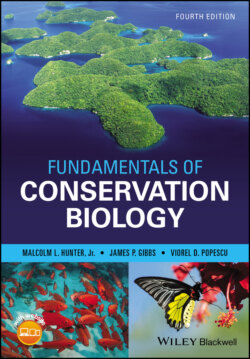Читать книгу Fundamentals of Conservation Biology - Malcolm L. Hunter Jr. - Страница 76
Intrinsic Value
ОглавлениеWhether or not ecosystems have intrinsic value independent of the intrinsic value of their constituent species is an issue that hinges on a complex and controversial question. Are ecosystems superorganisms composed of tightly connected, synergistic systems built around a set of closely coevolved species? Or are they based on a loose assemblage of species that happen to share similar habitat needs and end up interacting with one another to varying degrees because they are in the same place at the same time (Fig. 4.3)? This question has stimulated ecologists for decades (McIntosh 1980). Undoubtedly, the truth lies somewhere between the poles presented here and varies somewhat from ecosystem to ecosystem, but for our purposes it is sufficient to note that the closer ecosystems lie to the “tightly connected” pole of the spectrum, the easier it is to acknowledge that they have intrinsic value.
Figure 4.3 Are ecosystems tightly connected systems of closely coevolved species, or are they a loose assemblage of species that happen to share similar habitat needs and end up interacting with one another?
If ecosystems do have intrinsic value, then conservationists need to protect some examples of each different type of ecosystem, especially those that are in danger of disappearing. Some types of ecosystems are rare because they occur only in uncommon environments. For example, cool forests and alpine areas are rare in Africa because the continent has relatively few mountains tall enough to support these ecosystems (Kingdon 1989). Other ecosystem types have become uncommon because of human activities. In particular, most types of forest and grassland ecosystems associated with fertile soils and benign climates have largely been converted to agricultural lands.
Conservationists recognize the importance of protecting a representative array of ecosystems, especially those that are extensive and undegraded (Watson et al. 2020), but they have not yet developed many endangered ecosystem lists, especially ones with legal status analogous to various official endangered species lists (see Fig. 4.4 and Table 4.3 for examples). An ambitious effort to create a global “Red List of Ecosystems” is underway; see iucnrle.org, Keith et al. (2013) and J.P. Rodriguez et al. (2015). Political hurdles may be paramount, but the challenges of classifying ecosystems discussed previously also play a role (Boitani et al. 2015). Are the spruce–fir forests that occur on a few summits in the southern Appalachians a different type of ecosystem from the spruce–fir forests that stretch across Canada? If so, they are a very rare ecosystem; if not, they are just a peripheral variation of one of the planet’s most widespread ecosystems. Decisions like this are absolutely critical if you are trying to protect ecosystems for their intrinsic values, but they are not nearly so important if your focus is on the instrumental values of ecosystems.
Figure 4.4 Some types of ecosystems are rare because most examples have been destroyed, for example tall grass prairies. Others, like Mediterranean temporary pools, were always a small portion of the landscape and have shrunk further. This is particularly unfortunate given their rich flora and fauna, especially invertebrates and amphibians that thrive where there are no fish.
(Viktor Loki/Shutterstock)
Table 4.3 A few governments have begun the process of protecting endangered types of ecosystems by listing types that are rare or threatened. Listed here are a few examples from four much longer lists.
Sources: Australia: deh.gov.au/epbc; Europe: europa.eu/legislation_summaries/environment/nature_and_biodiversity/l28076_en.htm; RSA: Mucina and Rutherford 2006; USA: Noss et al. 1995
| Australia |
| Aquatic root mat community in caves of the Swan Coastal Plain Cumberland Plain shale woodlands Eastern Stirling Range montane heath and thicket Lowland native grasslands of Tasmania Parched wetlands of the Wheatbelt region Temperate highland peat swamps on sandstone |
| Europe |
| Inland salt meadows Mediterranean temporary ponds Temperate Atlantic wet heaths Xeric sand calcareous grasslands Fennoscandian deciduous swamp woods Eastern white oak woods |
| South Africa |
| Atlantic sand fynbos Bloemfontein dry grassland Cape vernal pools Ironwood dry forest Legogote sour bushveld Lowveld riverine forest Swartland alluvium fynbos |
| United States |
| Longleaf pine forests and savannas in the southeastern coastal plain Tallgrass prairie east of the Missouri River and on mesic sites across range Wet and mesic coastal prairies in Louisiana Coastal strand in southern California Ungrazed sagebrush steppe in the Intermountain West Streams in the Mississippi Alluvial Plain |
